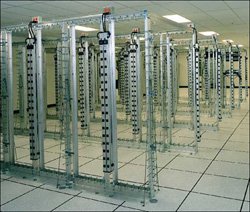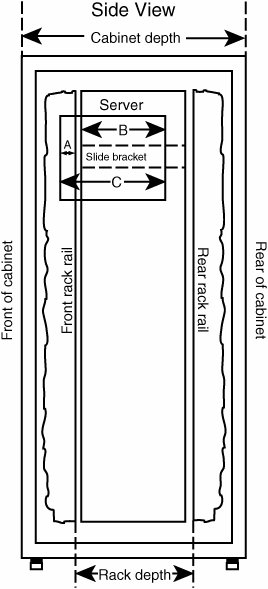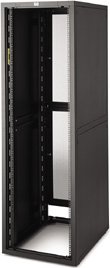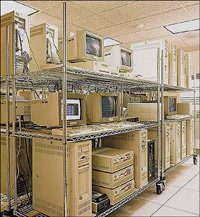Types of Racks
| Racks come in many types, and often the terms rack and cabinet are used to describe the same thing. You may also encounter the terms LAN racks, network racks, and computer racks as alternate terms for this type of server room furniture. Other industries, such as the telecom industry, have slightly different designs; you'll find racks for that industry called relay racks, an example of which is shown in Figure 16.3. Relay racks are used in the telecom industry to stack large numbers of switches. ISPs can also use this kind of rack for large router installations. Figure 16.3. This DAMAC open rack system is installed over a raised computer floor. The following are among the areas and industries that use rack-mounted solutions:
Some racks are open and very flexible to configure. Other designs are tightly sealed and locked cabinets. Different industries have different needs and standards. And, of course, different budgets allow for different features. The system shown in Figure 16.3 is considered to be a standard server rack, as specified by the Electronic Industries Alliance (EIA), as part of its EIA 310D standard. There are really two basic kinds of racks:
Because you can't lock an open rack, it is most common to find a rack of this type in a secure server room. A closed-bay rack can be secured with a lock, and although these systems tend to be more expensive, they are better choices when you use the server(s) outside a server room or in another nonsecure location. Not only can you secure a closed rack, but you also have greater control over its environmental system, including the filters, cooling devices, and so forth. Sizes of CabinetsIn specifying a cabinet size, you need to consider the amount of equipment that you want to put into the rack, which speaks to the rack's intended use. Racks come in some standard sizes, but you can also purchase racks in custom sizes. Most people opt for standard-size racks because they want standard-size components to fit into them. Cabinet size is usually measured from the outside of the cabinets. Figure 16.4 shows how you measure a standard rack or cabinet, using codified A, B, and C measurements:
Figure 16.4. How to measure the dimensions of a server rack. The rack depth is the distance from the front of the front rail to the back of the back rail. (Figure 16.4 shows a side view.) Not only does the internal rack dimension need to take into account the size of the components that fit into it, but there needs to be room in the back of the cabinet to run all the different wire connections that each component needs. Exterior dimensions must fit within the parameters of the room into which the rack will be installed. A server rack is a big, heavy beast, with some cabinets running as high as 7 feet tall and weighing as much as 300 pounds. Not only do you need to make sure that you can get the rack into your server room, you also must ensure that it will fit through any openings along the way, including elevators and doorways. Most rack frames are built to be rugged, and few of the ones you'll find in a data center will break down into smaller racks. The less expensive racks that are used in nondata center environments do often break down into their components or are shipped as small modules that can be rapidly snapped or bolted together. Universal RacksU, for rack unit, is an EIA standard unit of measure for most of the rack-mountable equipment on the market. The great majority of networking equipment and rackable servers all conform to this standard. Most large enterprise server and storage vendors offer standard, or universal, racks as part of their product lines. Figure 16.5 shows a Hewlett-Packard 5642 server rack as an example. Figure 16.5. Hewlett-Packard's 5642 server rack is an example of a standard, or universal, rack. A universal rack unit has the following dimensions:
Custom RacksMany vendors can and do build custom racks for specific applications on a build-to-order basis. Therefore, you will find several places where you can download a library of shapes that let you create your own rack designs. Most often these shapes are standard sizes and units of measures. The following are some of the companies that sell custom racks:
Wire ShelvingMany organizations, particularly smaller ones, opt for open wire shelving on which to place their servers. Wire shelving offers considerable flexibility in terms of placement of components as well as in portability within a location. Many companies offer this type of shelving. The classic stainless steel wire shelving is Metro shelving (www.metro.com), which is used in all kinds of industries. For example, Metro shelving is often used in fine food stores, hospitals, restaurants, kitchens, and even clean rooms where very low particulate counts are required. You can recognize Metro shelving by the trademark wavy "MMMM" rod that encircles the shelf. Figure 16.6 shows a Metro shelf system in use in a server deployment. Figure 16.6. Using wire shelving, like this system from Metro, is a very popular way to deploy servers. A very large number of vendors sell wire shelving for computer applications. In specifying a wire shelf system, the following factors are important:
|
EAN: 2147483647
Pages: 240



